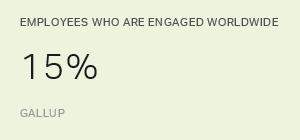
A Conversation With Beth Galetti
Amazon's Senior Vice President of Worldwide Human Resources
Larry Emond: In a recent conversation we had, you mentioned that at the top of your list of priorities was maintaining a consistent culture across all of Amazon, while still maintaining a startup mentality in each of the businesses. Please tell me more about how you go about doing that.
Galetti: Culture is very important to us at Amazon. When you look at our history, it's all been about builders innovating on behalf of customers, doing things that had never been done before. That's allowed us to invent everything from the Kindle to Alexa to Amazon Web Services. Because we have so much innovation and experimentation going on at any one time, it feels like we're a network of a thousand startups. And we love that. We want to continue focusing on our customers in a way that allows our employees to invent on behalf of those customers all the time.
Now that we've grown to over 500,000 employees, that creates a great opportunity for more inventors and builders to contribute to our customers. But it also creates the challenge of keeping that consistent culture that has made us successful.
As we grow, we have to be mindful of not losing sight of what made us successful in the first place.
Emond: So Beth, what are the things you're doing to make that possible?
Galetti: There are a few things that we do that help us stay consistent. First and foremost are our Leadership Principles. These are the living embodiment of our culture, regardless of job role or geographic location.
Amazon's 14 Leadership Principles
Emond: They don't look complicated.
Galetti: They are intentionally phrased in a simple and straightforward way to eliminate any confusion. You can't get through a day without referencing five or six of these principles -- "Are we thinking big enough?" "Maybe we need to get curious about this problem in a different way."
People are introduced to the Leadership Principles as part of the hiring process, and they are included in all elements of our employee development programs. They are the framework we use to ensure we make consistent decisions across all of our businesses, around the world.
Emond: Mechanisms are important too, right?
Galetti: Very much. You may have heard [Amazon CEO] Jeff Bezos say, "Good intentions don't work, but mechanisms do." A lot of people have great intentions, but at Amazon, we work to build mechanisms so that we can take those intentions and turn them into complete processes that we implement and inspect.
For example, one of our mechanisms is our interview process. It's set up to evaluate a candidate from the standpoint of our Leadership Principles. Individuals interview with employees as part of an interview "loop," and are asked about their prior experience using the Leadership Principles to guide the discussion. Each loop includes a "Bar Raiser," an Amazonian who receives extra training in the interviewing process to facilitate debriefs and determine if the candidate would raise the bar in terms of talent at Amazon -- this links back to our Leadership Principle of "Hire and Develop the Best." We have thousands of Bar Raisers at all different levels in the organization, all specially trained. They aren't the hiring manager and they usually aren't even on the hiring team. Bar Raisers aren't motivated to hire fast; they are motivated to hire well.
Emond: How long have you had Bar Raisers at Amazon?
Galetti: The Bar Raiser program has been around since 1999.
Emond: Do you use a structured interview with candidates? Where you ask the same questions every time?
Galetti: We offer a suite of questions to all of our interviewers as a starting point for topics they can discuss with candidates. But we also encourage our interviewers to Dive Deep (another Leadership Principle). We want each interviewer to learn more about the candidate and give the individual a better sense of what it's like to work here.
Emond: And the Leadership Principles? How long have you had those?
Galetti: The Leadership Principles have evolved over time. When Jeff Bezos founded the company in 1995, Amazon's mission was to be the world's most customer-centric company. The Leadership Principles became clear as our culture developed and were codified by the senior leadership team. We regularly review the Leadership Principles to ensure they are consistent with the changing demands of the business.
You can see signs of the Leadership Principles in everything we do. "Invent and Simplify" comes to life in things like the 1-Click ordering process. When you think of "Ownership," you recognize that every employee at Amazon is given stock as part of their compensation and benefits.
And, as I said, we periodically review the Leadership Principles to ensure they're still relevant. Just about two years ago, we added "Learn and Be Curious," because in a rapidly changing world we need people who are never done learning and always seek to improve themselves.
Emond: And you decided to put it up near the top.
Galetti: We did. I'm frequently asked if these are in any kind of a priority order, but the answer is no, they're all important.
Emond: Do you have a favorite?
Galetti: "Learn and Be Curious" is one of my favorites, along with "Earns Trust." You see these in action every day in leaders who listen attentively, speak candidly, and treat others respectfully. They're vocally self-critical, even when doing so is awkward or embarrassing. We are a feedback-rich culture and we're constantly evolving our thinking and looking for feedback from our employees. Part of being "Right a Lot" is that you need to learn and update your perspective over time. When an employee is presenting something, they'll encourage feedback and ask others to challenge their ideas.
Emond: Tell me about your unique white paper process.
Galetti: When we make decisions, we use a narrative process -- the six-page white paper. When someone comes up with a new idea for a business or service, they write a paper. This paper lays out the reasoning and approach, asks and answers tough questions, explains what else we considered and rejected in developing our suggestion, and even includes a draft press release that showcases the customer experience at launch. When the document is ready, team members meet in a conference room, sit quietly, and read the white paper. And only when everyone is done do we start the discussion.
This process helps us be "Right a Lot." When you hear those words, you might think that means Amazonians just need to be smart. But no. Good leaders who are right a lot may have strong judgment and good instincts, but they seek diverse perspectives and work to disconfirm their beliefs. So when we sit here and read a white paper, when we read a narrative, we're all listening to the full perspective of the presenter or the group who worked on that paper. And then, what follows is a discussion where everyone is expected to contribute, to question, to challenge, and to help make the right decision in the end.
Emond: Do you use the white paper process to make promotion and pay decisions?
Galetti: We do. When I first came to Amazon, I found it fascinating that when we look at promotions, it's not just about the employee's successes along the way, but it's also about their mistakes or failures and what they've learned. We want employees to be constantly learning. If you're looking to promote someone, you want to see that they have continued to evolve and progress, that they have taken risks, succeeded and failed, and grown in the process. Promotion white papers reflect both those successes and those failures, and they include reasons we shouldn't promote someone. It's a mandatory part of our promotion document. And it gets back to the humble nature of our culture. We recognize we all need to continue to improve. Leaders want to understand how we can help that employee continue their development, and to see the potential obstacles that might inhibit their success in their next role.
Emond: And where does the feedback in the promotion white paper come from?
Galetti: Usually the manager who's sponsoring the promotion will identify people who have worked closely with that employee and can give useful, concrete feedback.
Emond: In these pay and promotion decisions, do you use any kind of ratings or rankings?
Galetti: Our annual review process is called "Forte," and it focuses on an individual's superpowers and areas of strength. We gather the superpowers for each individual employee as part of their peer and manager feedback, and request areas for growth for the employee to work on.
One of the best parts about Forte is that we keep it brief -- 60 words or less each for the superpower and growth questions. We recognize that it's important to capture and provide this feedback, but we don't want the process to be burdensome either. We resist bureaucracy in our processes.
Emond: If you were to say how much of it is forward-looking versus backward-looking, what would the ratio be?
Galetti: The review is quite simply the superpowers and the growth ideas. It's a characterization of what makes an employee unique and special and valuable at Amazon. We expect conversations about performance to be ongoing between the manager and the employee throughout the year. We are a feedback-rich culture, so when we're reviewing a white paper or doing one-on-ones between managers and employees, there's constant feedback happening and I believe those are the best moments to be sharing performance insights. That's when we need to say, "Here's where I think you could have done better or handled the situation differently." Or "Here's where you did outstanding work, great job with this." Those things are much better served in the moment, in real-time, as opposed to in a backward-looking review that covers the course of a year. We're a company that moves really fast and I think it's important that we keep people focused on their strengths.
Emond: Do you provide managers with any kind of guidelines in that process? Do they have a conversation guide or things to cover?
Galetti: Absolutely. That's a really important piece because one of a manager's most challenging conversations is around sharing valuable feedback and areas where an employee's growth needs support. Again, we expect every leader at this company, actually every employee, to be assisting with hiring and developing the best. And so we have a variety of online training and coaching programs available, and many ways that we support managers in that process.
Emond: Which nails how you keep things common across a huge company. So how do you allow the thousand businesses within Amazon to play like startups?
Galetti: It starts with being focused on the customer. For example, if you're on the Alexa team, and focused on improving the quality of the music that Alexa delivers, you need to think of Alexa serving as a fantastic acoustic speaker. You're focused on that customer experience, and so that's where you put your efforts.
If you're working in our consumer organization and helping expand the selection of products in Amazon Fashion, you're focused on the customers who are engaging with us from that perspective. And with different employees focused on different aspects of that customer interaction, it naturally decentralizes how we're thinking about things. We use concepts here called "single-threaded" and "two-pizza" teams.
Emond: Explain, please.
Galetti: So single-threaded teams are how we typically structure and organize ourselves. A single-threaded team is what it sounds like -- it is a team that is focused on a single, specific customer opportunity or pain point. The leader of the entire team, whether a software developer, product manager, or financial analyst, needs to be able to deliver for the customer. They wake up every day thinking about that problem. We keep those teams small -- when we're working through a tough problem or a big opportunity, we bring together a team that, as it might sound, you can feed with two pizzas. Maybe four to eight people. And those singularly focused, nimble teams allow the innovation to be connected to the customer so we can deliver fast, valuable results.
Emond: When did single-threaded, two-pizza teams become mechanisms?
Galetti: Many of these things go back to our inception. I wasn't here in 1995. I wish I had been; it would have been just a really fun time. But when you think about it, the things that have not changed for Amazon have been staying very focused on the customer, setting ourselves up to constantly innovate on behalf of those customers, and doing it as quickly as possible. Having small, nimble teams gives us the best chance for success.
If you think of any startup, that's how it's organized. It starts as a single-threaded team focused on a problem. It's not 1995 anymore, but we still operate with the startup mentality in mind -- or, as we call it, the Day One mentality.
Emond: It's an argument for saying that the fact that you're 500,000 people is irrelevant. You get the benefits of size without the negatives.
Galetti: I think that's one way to look at it. You know, we stepped back and tried to figure out what things that my team, as an HR organization, should be doing to support the company. Being a support organization, we always question how we're delivering value for the company. We're a cost to the company, so we have to be sure that we're delivering value. To keep us customer-centric, we use tenets. [Read Amazon's human resource tenets at the end of the interview.] Our first tenet, for example, is "Employees come to Amazon to do meaningful work, and we make that easier by removing the barriers, fixing defects, and enabling self-service. Applying to, working at, and leaving Amazon should be frustration-free experiences." We're constantly looking for defects in our processes. Sometimes the obstacle is just the nature of our scale. How many levels of approval are required to get something approved or to hire someone? And are those levels of approval necessary? We're constantly challenging ourselves in those areas because we have taken our goal within HR to build a workplace for Amazonians to invent on behalf of customers. That's what we believe our role is, our mission.
HR can't be too prescriptive. We use our tenets as guiding principles, then we hire smart people and those smart people make good decisions using our Leadership Principles. And it is a challenge for a company our size. We want it to feel like you're part of a startup when you're here. Employees come to Amazon because they want to be builders. And we want to make sure that if anything is getting in their way of being a builder, we remove that barrier or fix that defect. I think that's a very important role of the HR organization.
Amazon's HR Tenets:
We build a workplace for Amazonians to invent on behalf of customers.
Employees come to Amazon to do meaningful work, and we make that easier by removing barriers, fixing defects, and enabling self-service. Applying to, working at, and leaving Amazon should be frustration-free experiences.
We seek to be the most scientific HR organization in the world. We form hypotheses about the best talent acquisition, talent retention, and talent development techniques and then set out to prove or disprove them with experiments and careful data collection.
As we develop new programs and services, we work backward from the employee and candidate, understanding our work has a direct impact on customers. We prioritize work that results in measurable impact for our customers.
We acknowledge that no process or policy can be so well designed as to properly cover every situation. When common sense is at odds with one of our policies or practices, we make high-judgment exceptions.
We seek to be the most technically proficient HR organization in the world. Our team includes dedicated engineers, computer scientists, and principals who develop world-class, easy, and intuitive products for candidates and employees.
We manage HR as a business, and we must scale faster through technology and simplified processes rather than through HR headcount growth. We rigorously audit ourselves to disrupt and reinvent HR industry standards.
We favor straightforward, two-way communications. When we talk about our work, we use plain language and specific examples over generalizations and corporate-speak.
Explore other CHRO conversations:
- Dignity Health EVP and CHRO Darryl Robinson
- Sanofi CHRO Roberto Pucci
- Microsoft CHRO Kathleen Hogan
- Mayo Clinic CHRO Cathy Fraser
- Roche CHRO Cris Wilbur
- ABB CHRO Jean-Christophe Deslarzes
- Roche CHRO Cris Wilbur and Global Head of Talent Innovation Tammy Lowry
- Genpact CHRO Piyush Mehta
- Schlumberger HR Chief Gavin Rennick
- Huntington Ingalls Industries CHRO Bill Ermatinger
- UBS Group Head Stefan Seiler
Jennifer Robison contributed to this article, which was based on an interview conducted by Larry Emond.


